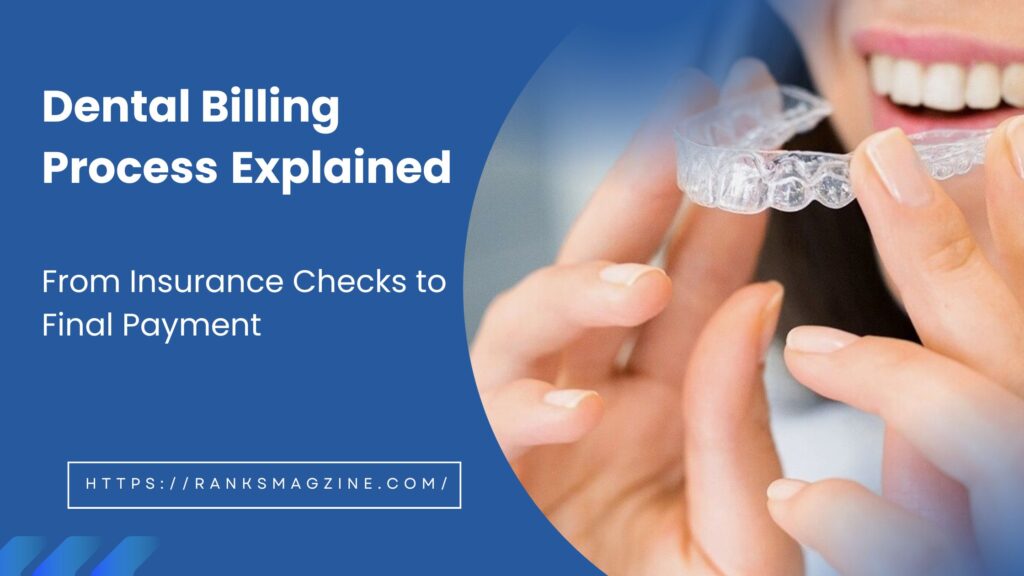Dental billing isn’t just paperwork—it’s how your practice gets paid. One mistake in coding or one missed detail in a claim can delay payments for weeks. In some cases, it means the money never comes at all.
According to the American Dental Association (ADA), nearly one in four dental claims faces delays due to missing or inaccurate information. Insurance companies don’t chase after practices to fix errors—they deny the claim or reduce the payment. That’s lost revenue.
This guide explains each step of the billing process in plain language. Whether you’re a solo dentist, office manager, or new to dental billing, it walks through what happens from the moment a patient walks in until the final payment is posted.
Step 1: Check the Insurance—Don’t Skip It
Before doing any kind of treatment, it’s smart to double-check what the patient’s insurance actually covers. A lot of practices skip this step or assume coverage based on past visits—and that’s usually where the problems start.
Most patients assume their insurance will cover “whatever’s needed,” but that’s rarely the case. A 2023 NADP survey showed that about 77% of patients don’t know what their dental plan includes—which leaves you, the provider, stuck figuring it out.
What You Actually Need to Confirm:
- Is the plan still active?
- Are basic things like exams, cleanings, or X-rays covered?
- Are there limits on how often certain procedures are allowed? (Like cleanings only every six months?)
- Has the patient already hit their yearly max?
- Do they have a deductible left to meet?
Some insurance plans also have waiting periods for more expensive procedures like crowns or bridges. If you don’t catch that in advance, you’ll either have to delay treatment or eat the cost.
The Right Way to Do It:
Don’t rely on what the patient tells you. Either call the insurance company directly or use the online verification portal tied to your dental software. Make a note of who you spoke with, the date, and the reference number. That small habit can save you hours later if there’s a dispute.
Also, don’t wait until the day of the appointment. Check insurance at least 1–2 days before, so if there’s an issue, you have time to handle it without scrambling.
Step 2: Get the Codes Right the First Time
Every dental procedure has a code. Get it right, and the claim moves forward. Get it wrong—even by a little—and you’ll probably have to resubmit. That means delays and possibly less money.
Dental billing uses CDT codes, set by the American Dental Association. These codes are updated every January. Using last year’s codes—or applying the right code to the wrong situation—is one of the fastest ways to lose money on a claim.
According to the ADA’s 2022 Claim Rejection Report, about 1 in 5 denied dental claims were tied to coding mistakes. Most of those came from:
- Picking the wrong code
- Forgetting details like tooth numbers or surfaces
- Leaving out documentation (like a dated X-ray)
Real Example:
A full-coverage crown might be coded as D2740. But if you mark it without confirming whether the tooth has had a root canal, or if it’s on an implant, the code might need to be different. Or take a routine cleaning—D1110 is for adults, but D1120 is for kids. Mix them up, and the claim gets rejected.
What You Can Do:
- Keep a current CDT codebook nearby, or make sure your billing software is updated.
- Ask for clarification from the provider when in doubt. Rushing leads to rework.
- Add the right notes and attachments—insurers often ask for X-rays, perio charting, or narratives, especially for things like scaling (D4341, D4342) or crowns.
The code isn’t just about the procedure—it tells the insurance company why the procedure was done. If your claim doesn’t tell the full story, expect it to come back.
Step 3: Send the Claim Before the Clock Runs Out
Once the procedure is done and coded, the next step is simple: send the claim. But this is where a lot of offices fall behind—not because it’s hard, but because it gets pushed to the end of the day or end of the week.
Most insurance companies give you 90 to 180 days from the date of service to get the claim in. Miss that window, and they won’t pay—even if everything else is perfect.
A 2022 survey by the Health Policy Institute found that 6–9% of dental revenue is lost every year due to delayed or missed claim submissions. That’s not a billing software issue—it’s a workflow issue.
What to Double-Check Before You Submit:
- Patient name and insurance ID match the card
- CDT codes are correct for the procedure
- Tooth numbers are included (if required)
- Notes and X-rays are attached (especially for crowns, scaling, or extractions)
- Payer info is accurate
Most claims are sent electronically using software like Dentrix or Open Dental. It’s fast, but fast doesn’t mean error-free. If something is missing, the claim bounces back—sometimes days later—and the clock keeps ticking.
A Simple Habit That Works:
Submit claims the same day the treatment is done. Not next week. Not when you “get to it.” One claim missed today can turn into five by Friday. And always keep a record of submission—either a digital confirmation or screenshot—so you have proof if the insurance company pushes back.
Step 5: When a Claim Gets Denied, Fix It—Don’t Ignore It
Every dental office deals with denied claims. It’s part of the job. But ignoring them—or not following up properly—means lost revenue. According to the 2023 CAQH Index, around 14% of dental claims are denied or rejected on first submission. And of those, about half are never corrected or appealed.
That’s money left on the table for work you already did.
Why Claims Get Denied:
- Missing or incorrect CDT codes
- Lack of required documentation (X-rays, perio charts, clinical notes)
- Frequency limits (like cleanings done too close together)
- Patient’s plan didn’t cover the service
- Insurance terminated before the visit
Each denial comes with a reason code—don’t skip reading it. These codes explain exactly why the claim failed. Some are easy fixes. Others may need an appeal.
What You Can Do:
- First, double-check your notes, codes, and documentation. Make sure everything lines up.
- If it’s your mistake, correct and resubmit. No need for an appeal.
- If the insurance is wrong (and that happens often), submit an appeal with a short, clear explanation and backup (like chart notes or a dated X-ray).
You usually have 30 to 90 days from the denial date to file an appeal. Don’t wait. Add a reminder to your billing workflow so no deadlines get missed.
💬 Quick Fact: Dental Economics reported in 2022 that outsourcing detnal billing helps practices recover 12–18% more revenue, often because appeals and denials don’t fall through the cracks.
Quick Tip:
If you call the insurance company, write down the rep’s name, date, and reference number. That small note can make a big difference if there’s a dispute later.
Step 6: Billing the Patient—Be Clear, Be Timely, and Follow Up
After insurance pays their share—or denies part of the claim—the rest goes to the patient. This is where things can get tense if the process isn’t handled clearly.
According to a 2022 report from Rectangle Health, 68% of dental patients say they’re confused by their bills, and more than half delay payment if they don’t understand the charges. Confusion leads to delay, and delay means more time spent chasing money.
Keep It Simple:
- Send bills within a few days of the EOB arriving—not weeks later.
- Make sure the bill includes:
- Date of service
- Procedure description
- Insurance payment
- What’s left for the patient to pay
- Include a phone number in case they have questions. Most patients just want someone to explain it.
Best Practices:
- Offer multiple ways to pay: online portal, credit card, or payment plan.
- Avoid vague lines like “balance forward” or “statement total.” Be direct.
- Set a clear due date, and follow up after 14–21 days if payment hasn’t been made.
If a patient can’t pay in full, be realistic. It’s better to set up a 3-month plan and get paid slowly than to send it to collections and get nothing.
Last Tip:
Keep the tone of follow-ups polite, but consistent. A quick phone call or reminder email often works better than sending multiple bills that go unopened.
Conclusion: Billing Isn’t Just Paperwork—It’s How You Get Paid
Dental billing isn’t complicated because of the software or the codes. It’s complicated because every small step—checking insurance, coding, submitting claims, reading EOBs, handling denials, and billing patients—can impact how fast and how much you get paid.
And when things go wrong, they don’t always show up right away. A $40 underpayment here or a missed appeal window there can quietly chip away at your practice’s income.
Whether you handle billing in-house or work with a third-party service, the most important thing is consistency. Verify insurance before the visit. Use the correct CDT codes. Read the EOB before posting. Fix denials instead of ignoring them. Send clear, timely patient bills.
One missed step might not hurt today. But over time, it adds up. And so does getting it right.


